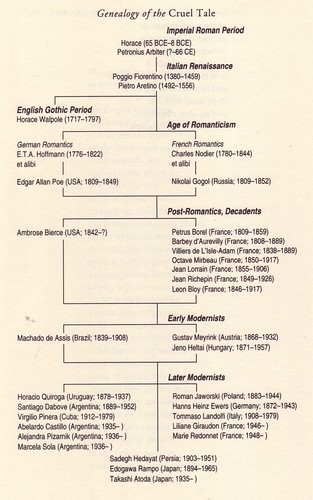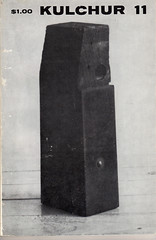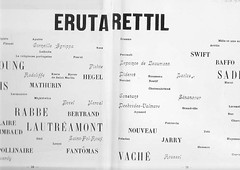Most of the evening was spent on researching JRMS interview[1] with Gilbert Alter-Gilbert:
Gilbert Albert-Gilbert’s Genealogy of the Cruel Tale from Bakunin v.6, 1997) [1]
and especially Gilbert‘s intriguing “Genealogy of the Cruel Tale“[2] a perfect example of the kind of thematic literary criticism I’m rather fond of. The chart reminds of the aestheticization of violence and cruelty in general, of which Nietzsche said:
- “One ought to learn anew about cruelty,” said Nietzsche (Beyond Good and Evil, 229), “and open one’s eyes. Almost everything that we call ‘higher culture‘ is based upon the spiritualizing and intensifying of cruelty….”
For your pleasure, here is the wikified version (information is scarce on the 20th century authors mentioned):
Overview
Genealogy of the Cruel Tale is a chart by American intellectual Gilbert Alter-Gilbert documenting the origins of the cruel tale, which begins etymologically with Auguste Villiers de l’Isle-Adam‘s Contes cruels anthology and has content- and style-wise similarities with cult fiction and horror fiction, Dark Romanticism and the roman frénétique, black humor, transgressive fiction, grotesque literature and folk tales. Sholem Stein says that it is a continuation of the research done by Breton in Anthology of Black Humor. Texts such as Walter Scott‘s On the Supernatural in Fictitious Composition, Lovecraft‘s Supernatural Horror in Literature, Mario Praz‘s Romantic Agony and Todorov’s The Fantastic: A Structural Approach to a Literary Genre also come to mind. Notably absent is Sade.
Taxonomy
- Imperial Roman Period
- Horace (65 BCE4 BCE)
- Petronius Arbiter (?- 66 CE)
- Italian Renaissance
- Poggio Fiorentino (1380-1459)
- Pietro Aretino (1492-1556)
- English Gothic Period
- Horace Walpole (1717-1797)
- Age of Romanticism
- German Romantics
- E.T.A. Hoffmann (1776-1822)
- French Romantics
- Charles Nodier (1780-1844)
- American Romantics
- Edgar Allan Poe (USA; 1809-1849)
- Russian Romantics
- Nikolai Gogol (Russia; 1809-1852)
- German Romantics
- Post-Romantics, Decadents
- Ambrose Bierce (USA; 1842-?)
- Petrus Borel (France; 1809-1859)
- Barbey d’Aurevilly (France; 1808-1889)
- Villiers de L’Isle-Adam (France; 1838-1889)
- Octave Mirbeau (France; 1850-1917)
- Jean Lorrain (France; 1855-1906)
- Jean Richepin (France; 1849-1926)
- Leon Bloy (France; 1846-1917)
- Early Modernists
- Machado de Assis (Brazil; 1839-1908)
- Gustav Meyrink (Austria; 1868-1932)
- Jeno Heltai (Hungary; 1871-1957)
- Later Modernists
- Horatio Quiroga (Uruguay; 1878-1937)
- Roman Jaworski (Poland; 1883-1944)
- Santiago Dabove (Argentina; 1889-1952)
- Hanns Heinz Ewers (Germany; 1872-1943)
- Virgilio Pinera (Cuba; 1912-1979)
- Tommaso Landolfi (Italy; 1908-1979)
- Abelardo Castillo (Argentina; 1935-)
- Liliane Giraudon (France; 1946-
- Alejandra Pizarnik (Argentina; 1936-)
- Marie Redonnet (France; 1948- )
- Marcela Sola (Argentina; 1936- )
- Sadegh Hedayat (Persia; 1903-1951)
- Edogawa Rampo (Japan; 1894-1965)
- Takashi Atoda (Japan; 1935-)

















